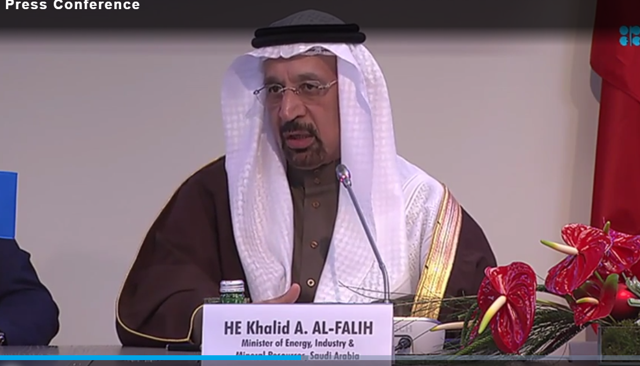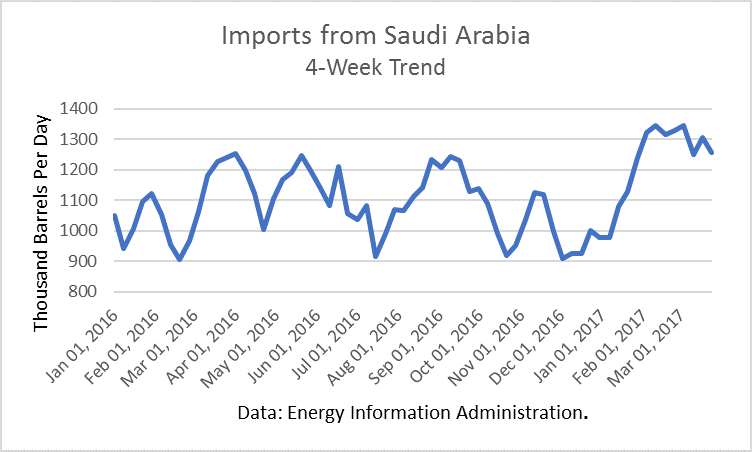
Crude oil was the worst-performing asset in the first quarter of 2017, losing 5.9 percent. That period coincided with the first three months of the OPEC-non-OPEC production cutbacks, which were intended to reduce global inventories and support oil prices.
Instead, global stocks increased from end-December through February. And U.S. crude stocks built by a staggering 57 million barrels through March. In addition, based on the Energy Department’s weekly data, U.S. crude production rose by 429,000 b/d from end-December through end-March. The Saudi Energy Minister, Khalid Al-Falih, had said during the OPEC press conference on December 10th that he did not expect any increase in U.S. production for all of 2017.

Source: OPEC
Saudi Arabia claimed to cut its production effective January 1st, but crude imports from KSA to the U.S. soared until the final week of March. In the YTD through March 24th, imports were up by 17% from the same period in 2016, and by 30% from December.

OPEC held its compliance monitoring meeting toward the end of March. It said it would make a determination of whether to extend the production agreements for the second half of 2017 at the regular OPEC meeting toward the end of May.
According to the Saudi minister in February, there are two criteria that will determine the issue: how close global OECD stocks are to their 5-year average, and how compliant OPEC and non-OPEC producers are to the agreements. He made a point of saying that KSA would not tolerate “freeloaders.”
As of this writing, OECD stocks are 293 million barrels above its 5-year trend, so there is little doubt that the cut will need to be extended. The main question becomes how much “free-loading” may take place that may kill the deal or weaken it greatly.
United States
OPEC Secretary General Mohammed Sanusi Barkindo has said that any agreement that does not include U.S. producers is “incomplete.” And he met with U.S. shale oil executives at a conference in Houston in March. But it is illegal for American companies to collude with OPEC. And so American oil companies will be “freeloaders” benefiting for any price effect created by production cutbacks.
Big Oil has decided to focus on shale oil, which is “short cycle,” quick to produce. Exxon Mobil, Royal Dutch Shell and Chevron say they will invest $10 billion altogether this year.
According to Goldman Sachs, “2017-19 is likely to see the largest increase in mega projects production in history, as the record 2011-13 capex commitment yields fruit. This long-lead-time wave of projects and a short-cycle revival, led by U.S. shales, could create a material oversupply in 2018-19.”
The Energy Department projects that December production will be 9.5 million barrels per day, about 750,000 b/d more than December 2016. I think it will likely be higher because it is already at 9.2 million.
Iraq
Iraq’s oil minister said that the country plans to increase production by about 600,000 b/d by the end of 2017 to 5 million barrels per day. The country relies on oil revenues to meet 95 percent of its budget, and it has been in an economic crisis since 2014, when oil prices cratered.
It is in a costly war with ISIS and needs all the cash it can generate. It will likely again request an exemption from the agreement. If that is not granted, it may go ahead and increase production anyway.
Russia
Russian oil minister Alexander Novak reported that his country had reduced production by about 200,000 b/d from December, which is still short 100,000 b/d from the agreed cut.
Russia’s oil giant Rosneft’s spokesman said, “We think that in the long term global oil demand dynamics and reduced investment during the period of ultra low prices will balance the market, but that the risk of a price war resuming remains.”
Rosneft believes that the long-term stabilization of prices should also involve key consumers and regulators. Therefore, there is a risk that the deal will not be extended because U.S. shale will not join any production agreement.
Libya
Libya is not subject to the deal due to its loss of production following the overthrow in 2011 of Moammar Al Qaddafi. While the situation is not 100 percent secure, Libya is attempting to increase its production to about 1.2 million barrels per day, up about 500,000 b/d from its most recent level. Though not considered “freeloading,” such an increase weakens the impact of the cuts by the other producers.
Nigeria
Nigeria is also exempted from the deal because its output had been interrupted by internal strife. Nigeria’s production dropped to 1.6 million barrels per day in March due to the Turnaround Maintenance at Bonga by Shell Nigeria Exploration and Production Company (SNEPCo).
SNEPCO has completed the repair and expects crude oil production to increase from April 2017. The International Monetary Fund expects a significant increase in Nigeria’s crude oil production in 2017. It claims a capacity of 2.5 million barrels per day.
Conclusions
There is little doubt that OPEC will need to rollover the deal to the second half of 2017 because oil inventories remain bloated. However, there are risks that KSA will not want to act virtually unilaterally, and that Russia and Iraq will not go along. Even with the extension of the cut, there may be a lot more crude on the market in the second half of 2017.
Check back to see my next post!
Best,
Robert Boslego
INO.com Contributor - Energies
Disclosure: This contributor does not own any stocks mentioned in this article. This article is the opinion of the contributor themselves. The above is a matter of opinion provided for general information purposes only and is not intended as investment advice. This contributor is not receiving compensation (other than from INO.com) for their opinion.

Hello,
Thanks for a realistic , unbiased and in depth analysis . I really appreciate the effort and may God bless you.
Regards: Shahid
Not to worry. Murkans are always at the ready to start buying bigger, less fuel efficient cars and increase needless driving, especially in light of the fact that their so-called "leaders" choose to sell them the idea that humans' destruction of the ecosystem is a "hoax." As long as they're sold on the idea that more fuel consumption can be cheap and harmless, they will continue to behave like an infestation.
Hear hear!
"So Called Leaders", blah, blah, blah. Nothing like a disgruntled Liberal entertaining us with his short sided
comments. Oil is a global commodity and regardless of the USA's driving habits, which should not be determined
on the basis of "Climate Change", use of autos, trucks, airplanes, ships and trains in India, China, Russia, wherever,
will continue to grow at a steady pace. It portends an energy balance is on the horizon.